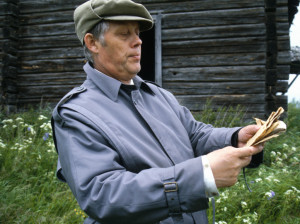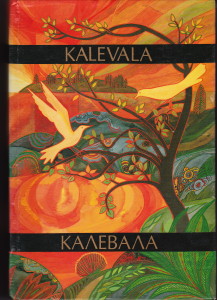Eino Kiuru and Armas Mishin 1998
The Russian translation by the Ingrian Finns Armas Mishin(later Hiiri, 1935–2018) and Eino Kiuru (1920–2015) was published in 1998. The translation is genuinely able to compete with the translation by Leonid Belskij (1888) which is regarded as a classic.
Mishin and Kiuru valued Belskij’s translation but they wanted to offer the reader a translation that would be closer to the original work. By this they meant both the accuracy of the words and also creating a translation that, in its spirit, is more close to the original work. Leonid Belskij had translated the Kalevala, the heroic tale of the Finnish people, and consequently, the firm notion in Russia was that the Kalevala is a heroic epic. On the other hand, Mishin and Kiuru, were of the opinion that since there are so many lyrical songs and poetic spells in the Kalevala its tone is not at all heroic, something which a Russian reader might have thought based on the translation by Belskij. They chose, as their starting point, the philosophy and view on life of the peasant, in which spells and words accomplished more than a sword.
Besides the exactness of the contents, Mishin and Kiuru strived for and managed to convey the characteristics and stylistic methods of oral folk poetry, as the rich metonymy, the repetitiveness of the verses and even the repetitiveness inside a verse:
Конь несется – путь короче,
сани мчатся – цель все ближе.
Virkku juoksi, matka joutui,
Reki vieri, tie lyheni.
(Poem 12:307–308)
Mishin and Kiuru tried to ascertain the meaning of every word and verse in the Kalevala and their translation is, indeed, more close to the original book than any other previously published Russian translation of the Kalevala

Armas Mishin sought inspiration for the work with translating the Kalevala in White Karelia. In this photo he studies newspapers that have been found in an abandoned house in the village Ponkalahti in 1990. Photo: Markku Nieminen.
The ethnographic exactness of the translation is outstanding. All names of things and their specific parts have been translated exactly, whether the word relates to hunting weapons, looms, rye, a grindstone or a boat. Many of these words are as unfamiliar to today’s Russian readers as their Finnish equivalents are to today’s Finnish people. The glossary at the end of the book helps when the reader tries to understand the words. The glossary contains explanations of all the words in the translation, including dialects.
A scuffle because of the Kalevala
The translation by Mishin and Kiuru sparked many discussions in White Karelia when it was published. According to Zamir Tarlanov, who was a professor of Russian language and literature, making the epic more archaic was too much. The famous researcher criticised the translation for not following the style which is characteristic for this form of tradition, epic poetry, and he also characterised the translation as flat and he considered it to be a failure. Just like Tarlanow, who did not know Finnish, other reviewers of the translation had not been able to compare the translation by Mishin and Kiuru to the Kalevala by Lönnrot. The source for their review was the translation by Leonid Belskij.

Eino Kiuru participated in a trip to White Karelia, which was arranged in connection with a symposium for translators of the Kalevala in 1999. In this photo he collects “väki” or force from the birch tree that had been the fountain of strength for the wise man, Tsinkki-Riio, from Ponkalahti. Photo: Markku Nieminen, Juminkeko.
However, the most harsh review did not come from the experts and the target was not the translation as such, but the fact that on the cover of the Russian translation of the Kalevala by Mishin and Kiuru was the name Elias Lönnrot. The same topic, that had been discussed in the 1980’s when the Kalevala celebrated its 150th anniversary, emerged again and very heatedly so. The debate concerned the issue to whom the Kalevala belongs: is it a treasure of Finnish or Karelian culture.
A small group, who partly used pseudonyms, again began to claim in the press and other media that the Kalevala is a piece of work that directly comes from the Karelian people. Lönnrot had only served as scribe. Armas Mishin has for more than a decade worked relentlessly when trying to inform newspaper readers in the regions and nationwide, and in journals with an even larger circulation, about the birth process of the Kalevala.
The debate has even led to a scuffle during a lecture that was held in the Karelian national library, when the enthusiasts lacked words for their feelings and viewpoints. Nevertheless, several passionate “defenders of the creativity of the people” do not know the contents of the Kalevala. Among them are critics who do not know Finnish or Karelian languages and who, thus, would not even be able to compare the foundation of the poetic song material that can be found at the SKVR: Suomen Kansan Vanhat Runot (in English: The Ancient Songs of the Finnish People) to the text in the Kalevala.
Researchers, who have studied The Baltic Finnic people and their folk poetry and who know the language, rate the translations by Msihin and Kiuru high. The comparison of the translation and the original version is made easier as both texts have been published in parallel and, consequently, someone who knows the language can easily compare every verse and scrutinize every choice of word. Because of the collaboration between Eino Kiuru and Armas Mishin, Russian readers have, perhaps, received the most exact translation of the Kalevala.
Mirja Kemppinen ja Markku Nieminen: ”Rekonstruoidusta kansaneepoksesta Lönnrotin runoelmaksi – Kalevala Venäjällä” – Kalevala maailmalla. Helsinki: SKS. 2012.
See also the obituary by Markku Nieminen “Armas Hiiri 1935–2018“, Helsingin Sanomat 23.10.2018

